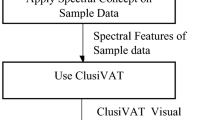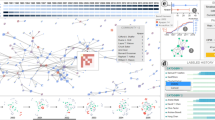Abstract
The Clustering algorithms cannot detect the number of clusters for unlabeled data. The visual access tendency (VAT) is recognized as the best approach for cluster detection. However, context-aware-based graphs (CAG) give more informative cluster assessment for VAT. Hence, we extend the VAT using CAG, known as CAVAT. This paper investigates the existing cluster detection methods and proposes a data clustering method for the CAVAT for archiving the efficient clustering results.
Access this chapter
Tax calculation will be finalised at checkout
Purchases are for personal use only
Similar content being viewed by others
References
Kanungo, T., Mount, D.M., Netanyahu, N.S., Piatko, C., Silverman, R., Wu, A.Y.: An efficient k-means clustering algorithm: analysis and implementation. In: Proceedings of 16th ACM Symposium on Computational Geometry, pp. 1–21 (2000)
Jain, A.K., Murthy, M.N., Flynn, P.J.: Data clustering : a review. ACM Comp. Surveys 31(3), 264–323 (1999)
Ester, M., Kriegel, P., Sander, J., Xu, X.: A density based algorithm for discovering clusters in large databases with noise. Int Conf. Knowl. Disc. Data Min. 226–231 (1996)
Zahn, C.T.: Graph theoretical methods for detecting and describing gestalt clusters. IEEE Trans. Comput. 20(1), 68–86 (1971)
Bezdek, J., Hathaway, R.: VAT: A Tool for Visual Assessment (Cluster) Tendency, pp. 2225–2230. Proc. IJCNN, Honolulu (2002)
Wang, L. et al.: Enhanced visual analysis for cluster tendency assessment. Adv. Knowl Data Mining, LNCS, 6118, 16–27(2010)
Havens, T.C., Bezdek, J.C.: An efficient formulation of the improved visual assessment of cluster tendency. IEEE Trans. Knowl. Data Eng. (2012)
Rajendra Prasad, K., Eswara Reddy, B.: An efficient visualized clustering approach for various datasets. IEEE SPICES 1–5 (2015)
Eswara Reddy, B., Rajendra Prasad, K.: Improving the performance of visualized clustering method. Int. J. Syst. Assur. Eng. (IJSA), Springer (2015)
Li, X., Hu, W., Shen, C., Dick, A., Zhang, Z.: Context-aware hyeprgraph construction for robust spectral clustering. IEEE Trans. Knowl. Data Eng. 26(10) (2014)
Zhou, D., Huang, J., et al.: Learning with hypergraphs: clustering, classification, and embedding. P. NIPS (2006)
Dubes, R.C., Jain, A.K.: Clustering methodology in exploratory data analysis. In: Yovits, M.C. (ed.) Advances in Computers. Academic Press, New York (1980)
Ozertem, U., Erdogmus, D., et al.: Mean Shift spectral clustering. Patt. Recog. 41(4), 1924–1938 (2008)
Senoussaoui, M., et al.: A study of the cosine distance-based mean shift for telephone speech diarization. IEEE Trans. Audio Speech Lang. Proc. 22(1) (2014)
Tang, H., Chu, S.M.: Partially supervised speaker clustering. IEEE Trans. Pattern Anal. Mach. Intell. 34(5), 959–971 (2012)
Wang, L., Nguyen, T., Bezdek, J., Leckie, C., Rammohanara, K.: iVAT and aVAT: enhanced visual analysis for clustering tendency assessment. Proc. PAKDD, India (Jun 2010)
Sledge, I.J., Huband, J.M., Bezdek, J.C.: (Automatic) Cluster count extraction from unlabeled data sets. In: Fifth International Conference on Fuzzy Systems and Knowledge Discovery IEEE Computer Society, pp. 3–13
Hathway, R., et al.: Scalable visual assessment of cluster tendency. Patt. Rec. 39, 1315–1324 (2006)
Bezdek, J.C., et al.: Visual assessment of clustering tendency for rectangular dissimilarity matrices. IEEE Trans. Fuzzy Syst. 15(5), 890–903 (2007)
Huband, J., et al.: Bigvat: visual assessment of clustering tendency for large datasets. Pattern Recogn. 38(11), 1875–1886 (2005)
Wang, L., et al.: Enhanced visual analysis for cluster tendency assessment and data partitioning. IEEE Trans. Knowl. Data Eng. 22(10), 1401–1413 (2010)
Belkin, M., Niyogi, P.: Laplacian Eigenmaps and spectral techniques for embedding and clustering. Adv. Neu. Inf. Proc. Sys. MIT Press (2002)
Wang, X., Mitchell, D.: A divide-and conquer approach for minimum spanning tree-based clustering 21(7), 945–958 (2009)
Weiss, Y.: Segmentation using Eigen vectors: a unifying view. Proc. IEEE Int. Conf. Comput. Vision 975–982 (1999)
Kabal, P.: Audio File web document. http://WWW.TSP.ECE.McGill.CA/Docs/AudioFormats
Cai, D., He, X., Han, J.: Document clustering using locality preserving indexing. IEEE Trans. Knowl. Data Eng. 17(2), 1624–1637 (2005)
Lovasz, L., Plummer, M.: Matching Theory. Budapest, Northholland (1986)
Otsu, N.: A threshold selection method from gray-level histograms. IEEE Trans. Syst. Man Cybern. 9(1), 62–66 (1979)
Author information
Authors and Affiliations
Corresponding author
Editor information
Editors and Affiliations
Rights and permissions
Copyright information
© 2016 Springer India
About this chapter
Cite this chapter
Rajendra Prasad, K., Eswara Reddy, B. (2016). Context-Aware Graph-Based Visualized Clustering Approach (CAVCA). In: Chaki, R., Cortesi, A., Saeed, K., Chaki, N. (eds) Advanced Computing and Systems for Security. Advances in Intelligent Systems and Computing, vol 395. Springer, New Delhi. https://doi.org/10.1007/978-81-322-2650-5_16
Download citation
DOI: https://doi.org/10.1007/978-81-322-2650-5_16
Published:
Publisher Name: Springer, New Delhi
Print ISBN: 978-81-322-2648-2
Online ISBN: 978-81-322-2650-5
eBook Packages: EngineeringEngineering (R0)




